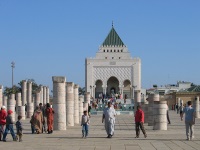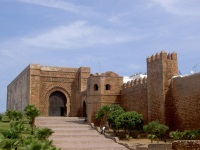
The massive Hassan Tower, which dates to 1195, is the minaret of a mosque and towers over the capital, Rabat. However, the huge Rabat Mosque itself was never completed and was largely destroyed in an earthquake in 1755.The mosque and the minaret were intended by the builders to be the largest in the world but today all that is left of the mosque is several walls in various states of ruin and 200 columns. Also, the minaret, made from striking red sandstone, is unusually situated at the centre of the mosque building, and was intended to be 262ft (80m) high, though it stands at 164ft (50m) today. Each façade of the minaret is intricately patterned with different motifs on each face.Opposite the mosque is the Mausoleum of Mohammed V, one of the great monuments of modern Morocco, inaugurated in 1967. The deceased king, Mohammed, lies entombed in white onyx, surrounded by royal guards, and hundreds of Moroccans pay homage by filing through the mausoleum each day. The tower, what remains of the mosque, and the modern mausoleum form an important historical and cultural complex which has been declared a UNESCO World Heritage Site and is a popular tourist attraction.

The Kasbah des Oudaias was recently added to UNESCO's list of World Heritage Sites and is a pleasant place to take a stroll and admire some interesting architecture.The Kasbah was the Alhomad citadel of medieval Rabat, and is guarded by an impressive arched gate built around 1195. Inside the Kasbah is the palace and Andalucian gardens, as well as a broad terrace, which gives beautiful views of the river and sea close to the city's oldest mosque, the Kasbah Mosque, founded in 1050. Below the terrace are several fortifications with gun emplacements guarding the estuary, and even further below is a beach, usually crowded with locals.The views from this ancient stronghold are marvellous, and a little café sits beside the palace, where visitors can have traditional mint tea and almond cookies while admiring the view. The winding alleys and characteristic blue and white buildings give the area a cool and peaceful allure.

Emerging from the boulevards of the Ville Nouvelle (New Town) of Rabat, one comes across the ruins of Chellah, once the thriving walled Roman port city of Sala Colonia, abandoned in 1154 in favour of Salé across the river mouth.In the time of the Almohads the site was used as a royal burial ground, and following this, the Merenid sultan, Abou El Hassan, added some monuments and the striking main gate in the mid-14th century. Just inside the gate are Roman ruins dating from 200 BC, which include a forum, a temple and a craftsmen's quarter.The citadel is now part of a garden and in spring the ruins are surrounded by a beautiful variety of flowers. The Chellah Gardens are entered through an ancient gateway created by the Almohads and notable ruins inside, apart from the Roman remains, include what is left of the small mosque dedicated to Abou Youssef, several elaborate tombs, and a stone minaret in the centre of the grounds. Visitors are welcome to wander freely and none of the ruins are off limits. The garden is a lovely place to spend some time and since 2005 has been the venue of an annual international jazz festival, Jazz au Chellah.

Volubilis, near the Moroccan town of Meknes, situated between Rabat and Fez, was a central Roman administrative city in Africa from around the third century BC, built atop a previous Carthaginian city. Volubilis was unique in that it was not abandoned after the Romans lost North Africa to the Arabs, with even the Latin language living on in the area for several centuries.Volubilis remained inhabited until the 18th century, when it was demolished to provide building materials for the palaces of Moulay Ismail in nearby Meknes, which meant that a great deal of the Roman architectural heritage was lost.Today the ruins are a UNESCO World Heritage Site and consist of some well-preserved columns, a basilica, a triumphal arch and about 30 magnificent mosaics. It is recommended that you have a knowledgeable guide for this site, as it is greatly enriched by knowing the background and context of what you are seeing. It takes a few hours to stroll around all the ruins and visitors should be sure to come prepared for the baking sun as there is little shade - drinking water, sunscreen and a hat will make all the difference, and comfortable walking shoes are also essential.

Travel Guide powered by Word Travels, copyright © 2023 Globe Media Ltd. By its very nature information in this travel guide is subject to change at short notice and travellers are urged to verify information on which they're relying with the relevant authorities. Neither Globe Media Ltd nor Travel Vogue can accept any responsibility for any loss or inconvenience to any person as a result of information contained above.